
THE BELGIAN BEER ODYSSEY
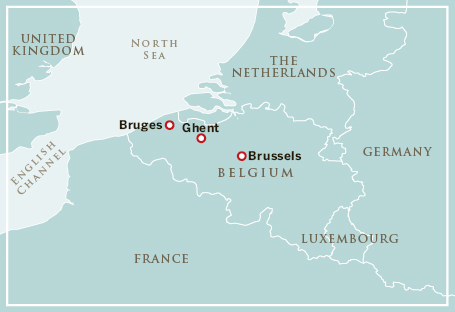
Little Belgium may be the butt of jokes – few famous people, lots of EU bureaucrats – but it is the Bordeaux of beer. The country’s 125-plus breweries make well over a thousand beers, drunk with sacramental zeal. No mere drink, beer is a shortcut to Belgium’s soul.
ESSENTIAL EXPERIENCES
* Learning all about your tipple at Brasserie Cantillon Brouwerij in Brussels – a museum of beer history.
* Driving or cycling through Flanders, stopping at small towns and breweries.
* Eating moules et frites on Brussels’ Grand Place, before heading into the city’s bars.
* Walking along the canals of Bruges, stopping awhile for a beer.
* Admiring the Ghent Altarpiece, a medieval masterpiece painted by the Van Eyck brothers in 1432 in St Bavo Cathedral, Ghent.
* Gazing at the guild halls on Grote Markt, Antwerp’s grand market square, surrounded by great beer bars.
* Seeking solace in Bruges’ Bequinage, a group of whitewashed homes for lay orders.
Flanders, Belgium’s northern province, is an idyllic agricultural landscape where cows graze by lazy rivers as church bells chime in the background. It’s also the beer centre of the world, where beer lovers pilgrimage to St Sixtus Abbey. Here, silent monks of the Trappist order brew Westvleteren 12: a revered beer available only at the abbey itself and in the nearby In De Vrede cafe.
But St Sixtus Abbey is merely the tip of the beer iceberg. For Belgium is the world’s most beer-friendly country, where connoisseurship meets camaraderie over goblets of rich, strong ale. Ghent, Antwerp, Brussels, Leuven – each town and city has bars offering hundreds of styles where you’ll learn how to assess a beer’s aroma before taking a sip. As the late beer writer Michael Jackson put it, Belgium has ‘the greatest variety of styles, the most gastronomically interesting specialties, and the most unusual beers in the world’. And, he might have added, the most exacting beer rituals – every good bartender knows how to serve each beer properly, with its own glass and beer mat.
In Belgium too, beer is part of gastronomy: not just for quaffing, but a connoisseurs’ experience. If Belgian food is ‘French food in German portions’, as the phrase has it, then Belgian beer is treated like wine: paired with food, poured carefully, bouquets savoured.
Belgium’s singular beer culture is due to its northern European location. Above the wine belt, and blessed with good-quality water, its position at the confluence of German and Latin cultures has been conducive to beer – as has its Catholic monastic culture, which from the Middle Ages onwards developed brewing as a revenue-raiser. Which is why Belgium’s six Trappist breweries, including St Sixtus Abbey, are still silently making some of the world’s best beers – and why each year, the world comes to drink them.
LOCATION BELGIUM | BEST TIME OF YEAR YEAR-ROUND | IDEAL TIME COMMITMENT FOUR DAYS | ESSENTIAL TIP DON’T DRINK AND DRIVE; STRICT DRINK DRIVING LAWS ALLOW ONLY UP TO 0.05MG OF ALCOHOL PER 100ML OF BLOOD | BUDGET $$ | PACK BEER MONEY, A RAINCOAT FOR UNEXPECTED SHOWERS AND SHOES THAT CAN COPE WITH COBBLES
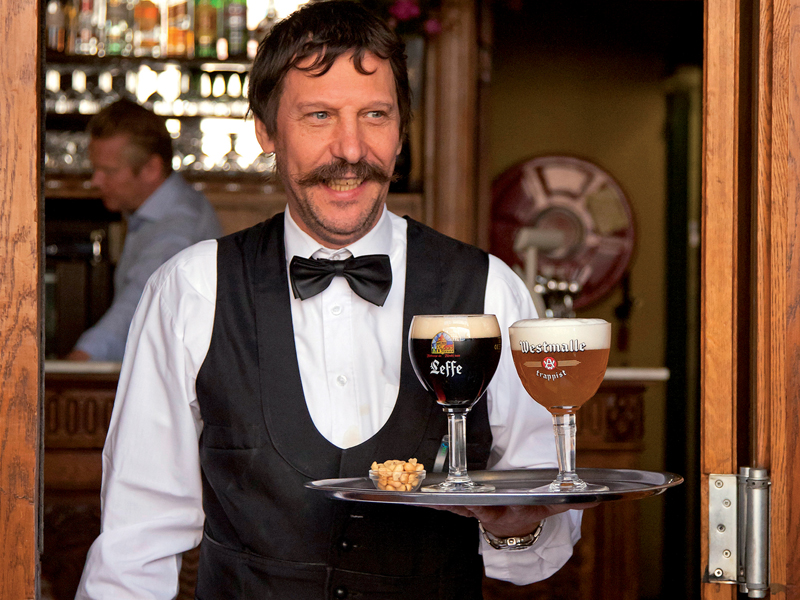
Belgium’s charismatic beers – funky, fruity and packing a punch – are produced by almost 200 breweries.
TOM MARTIN | AWL-IMAGES ©
TASTING NOTES
On a beer odyssey, know your Belgian beer styles. Pilsners are golden, served cold: think Stella Artois, Jupiler. Lambic is the Champagne of beers, naturally fermented by the Belgian air. Gueuze is a blend of young and old ferments. Kriek is a cherry beer, one of several Belgian beers brewed with fruit. Then there are white beers, brown ales and red ‘sour’ beers. Trappist means that the beer is brewed by Trappist monks; it comes in various styles, including Dubbel (like a brown ale) and Tripel (a pale ale of significant punch). Watch out for notes of coriander, liquorice and spices – and don’t be afraid to wax lyrical. Belgians do.
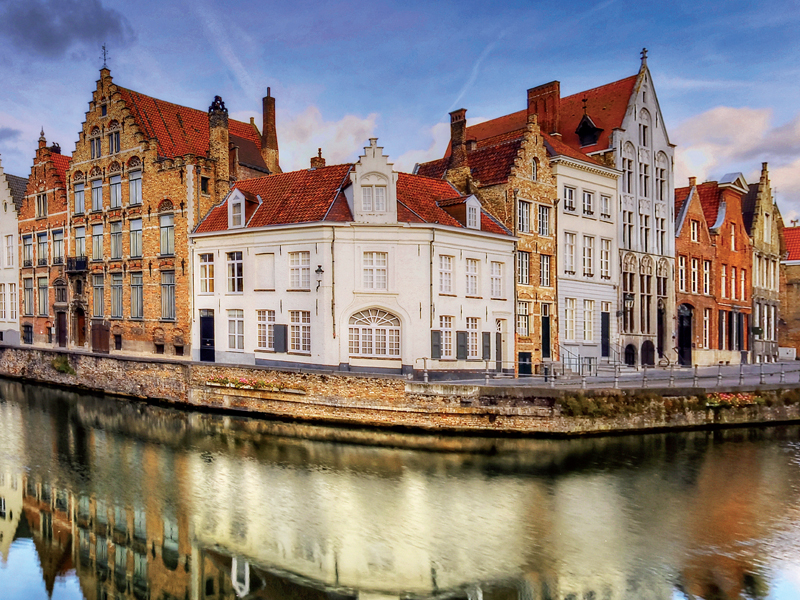
Merchants’ houses line the canals of Bruges.
AUBREY STOLL | GETTY IMAGES ©
BIKES, BEER AND FRITES
What would entice you to stand for hours beside a muddy roadside in icy April rain? In Belgium, it’s to watch a bunch of grimacing cyclists pound past. Bike racing is Belgium’s national obsession. Early-season one-day races, such as the Tour of Flanders (you can’t miss the flags of a black lion on yellow background), La Flèche Wallonne and Liège-Bastogne-Liège are known as the Spring Classics. The raucous spectators are fortified by beer, of course, and frites. No ordinary chips, these: they’re double-fried, crispy, and served in a cone with mayonnaise. You’ll need every calorie to keep warm waiting for the racers.
■ The Perfect Getaway
Come from northern France into the pastures of Flanders – the Flemish part of northern Belgium – and you’ll soon be drinking beer in medieval towns, where old guild houses and canals prove a perfect backdrop. Detour to Westvleteren, near the French border, where monks at St Sixtus Abbey make the pungent Westvleteren 12. If you’re driving, arrange stays at places like the Brouwershuis in Watou, a B&B owned by the St Bernardus Brewery.
In Bruges, a canal toytown of impossible quaintness, you’ll find a host of pubs, including owner Daisy Claeys’ famous Brugs Beertje, which serves over 300 brews – including the eccentric Kwak, served in a surreal glass supported by a wooden frame. In Ghent, the traditional De Dulle Griet stocks over 400 brews, while Antwerp’s Kulminator pips it with over 500. But it’s Leuven that claims the ‘beer city’ crown, both as the home of Stella Artois and what it calls the ‘longest bar in the world’: the combined forces of 40 pubs in the Oude Markt. Of course, the capital Brussels puts up a good shout. Here, you’ll eat moules et frites (mussels and chips) at an open-air restaurant before drinking at bars that include La Mort Subite (Sudden Death), where prices are chalked up on huge mirrors, and the historic gem De Ultieme Hallucinatie, where even the piano is art nouveau.
Some breweries open for visits, like De Dolle Brouwers in Esen, while brewpubs make unique offerings like Ghent’s Gruut, specialising in herby medieval recipes. With such a cornucopia, it’s odd to think that Belgium almost lost its beer culture to drink corporations in the 1970s. Thankfully, old traditions have been revived, and from Flanders down to French-speaking Wallonia, you’ll find many new beers to try. Just remember the words for ‘cheers’: proost in Flemish and santé in French.
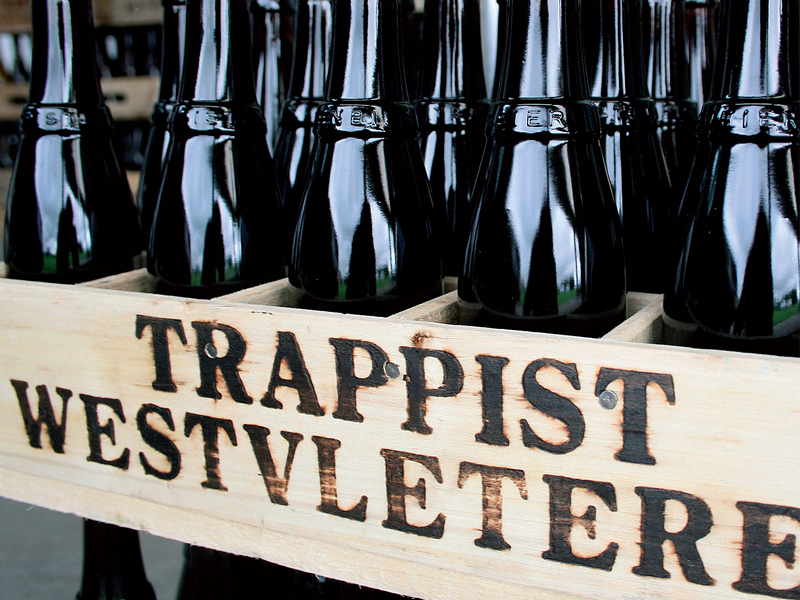
The tastiest beer in the world? Visit the Westvleteren monastery to decide.
CHRISTIAN HORSTEN | CORBIS ©
■ Plan It
You can reach Belgium by Eurostar from London and Paris. Airlines from around the world fly into Brussels, and Charleroi Airport hosts low-cost carriers. The best towns are Bruges, Ghent and the capital, Brussels, which hosts the Belgian Beer Weekend in the first weekend of September; the Bruges Beer Festival is held in February, and the Zythos Bierfestival – Europe’s largest beer-tasting festival – takes place in Leuven at the end of April.
■ Detour
Scars and souvenirs of WWI remain poignant attractions in the Flanders countryside, and no more so than in Ypres – or ‘Wipers’ as the British and Australian ‘Tommies’ called it – which is all the more extraordinary for having been meticulously rebuilt following the war.
Here, the Menin Gate and its Memorial to the Missing bears the names of the 54,896 fallen from British and Commonwealth troops whose bodies were never found. ‘To the British Armies of the Empire who stood here from 1914 to 1918’, the inscription reads, ‘and to those of their dead who have known no grave’. Each evening, the Last Post is sounded.
DECKCHAIR
* Great Beers of Belgium (Michael Jackson) The most authoritative beer guide.
* Magritte (David Sylvester) The great Belgian artist went to his studio every day and painted trains coming out of fireplaces. Plenty have argued that beer and Belgian surrealism are linked…
* Maigret and Monsieur Charles (Georges Simenon) Or any other book featuring Jules Maigret, one of Belgium’s great detectives.
* Food Culture in Belgium (Peter Scholliers) More than waffles, chocolate and chips, Belgian food is now feted – try mussels, eels, tarts and Gentse Waterzooi.
* Tintin (Hergé) Belgium is the world capital of bandes dessinées – comic books for all ages. The greatest of them all is Tintin.
* The Poisonwood Bible (Barbara Kingsolver) Evangelical Baptist Nathan Price takes his family to the Belgian Congo in 1959.
A CRAFTY TASTE OF CAPE TOWN
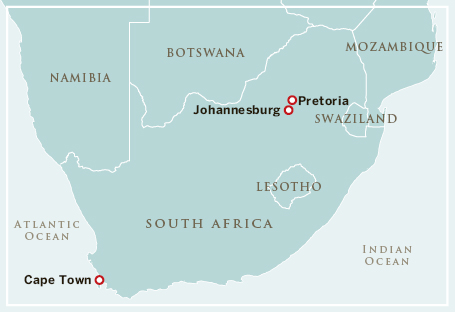
Culinary capital of South Africa, Cape Town is showing off its bountiful produce with a return to artisanal products. Explore the whole peninsula, from the City Bowl to Cape Point, to discover fine-food markets, exquisite wineries and innovative restaurants.
ESSENTIAL EXPERIENCES
* Browsing Neighbourgoods Market in Woodstock for artisanal foods.
* Popping into Escape Caffe in Bree St for serious coffee and cheesecake.
* Tasting the fish fresh off the boats at Kalk Bay harbour.
* Spreading a blanket on the grass, pouring local wine and tucking into a picnic hamper at one of the peninsula’s exquisite wine farms.
* Sharing a Bucket o’ Love at &Union (that’s craft beer bottles in a bucket!) while listening to live music on a Wednesday night.
* Sampling at least one of the cuisines from further north in Africa – Ethiopian, Nigerian or Cameroonian are all on offer.
It’s Bree St in central Cape Town on a warm summer’s afternoon, and time for an urban picnic at Jason Bakery. Here the picnic baskets are full of surprises like spicy soujouk or chorizo sausages, beer bread and farm butter, homemade pickles and chutneys, rillettes, prosciutto and chocolate crackle-top biscuits. Order a jug of gin and tonic garnished with cucumber, mint and lime to wash it down, and engage in some serious people-watching.
Jason himself is the new breed (or is it old breed?) of baker, firing up his ovens in the early hours to produce his famous bacon croissants and a wide array of breads, and fashioning other specialist foods by hand, like buffalo bresaola and pork pies. This is the trend. Local farmers, purveyors of fine foods, organic merchants, bakers, grocers, fishmongers, butchers and artisan producers of wines and craft beers are celebrated at markets, shops, restaurants and bars all over the peninsula. Capetonians love nothing better than a quick trip to the market on a week night, or a longer browse with lots of tastings on Saturday morning.
Dutch settlers arrived in 1659 to establish a garden so that sailors rounding the Cape wouldn’t die of scurvy, which probably makes the then governor Simon van der Stel the first garagiste winemaker in Cape Town! The peninsula is home to a handful of wineries, including the oldest of them all, Groot Constantia (established by Van der Stel). Others in the Constantia Valley offer tastings, restaurants and picnics. Just to prove that the Cape is not just about wine, tasty craft beers are also being produced in the area; suddenly, supping the amber nectar everywhere from fancy hotels to specialist bars is all the rage.
Dubbed the Tavern of the Seas, Cape Town offers a feast of culinary adventures. With a tradition that embraces African, Indian, European and Malay influences, South African cuisine is a fascinating mixture that’s waiting to be explored.
LOCATION CAPE TOWN AND THE CAPE PENINSULA, SOUTH AFRICA | BEST TIME OF YEAR OCTOBER TO MARCH | IDEAL TIME COMMITMENT TWO DAYS TO ONE WEEK | ESSENTIAL TIP DON’T DRIVE OVER THE LIMIT (0.05MG OF ALCOHOL PER 100ML OF BLOOD); DRINK DRIVING LAWS ARE STRICTLY ENFORCED | BUDGET $$ | PACK A HEALTHY APPETITE

The Groot Constantia vineyard stands near the neck of the Cape peninsula.
JOHN SNELLING | GETTY IMAGES ©
GREAT GRAPES
The Constantia Valley is home to the very first wine farm in South Africa: Groot Constantia. The elegant farmhouse is nestled under the Table Mountain range with views down to the sea. The museum, cellar tours, restaurant and tasting room will keep you busy. Klein Constantia, Buitenverwachting and High Constantia are a few of the other valley wineries, as well as Constantia Uitsig and Steenberg in Tokai. Some have superb restaurants and offer picnics on the lawns. Further south and on the Atlantic side of the peninsula is Cape Point Vineyards in Noordhoek. Taste the wines, then indulge in a picnic hamper.
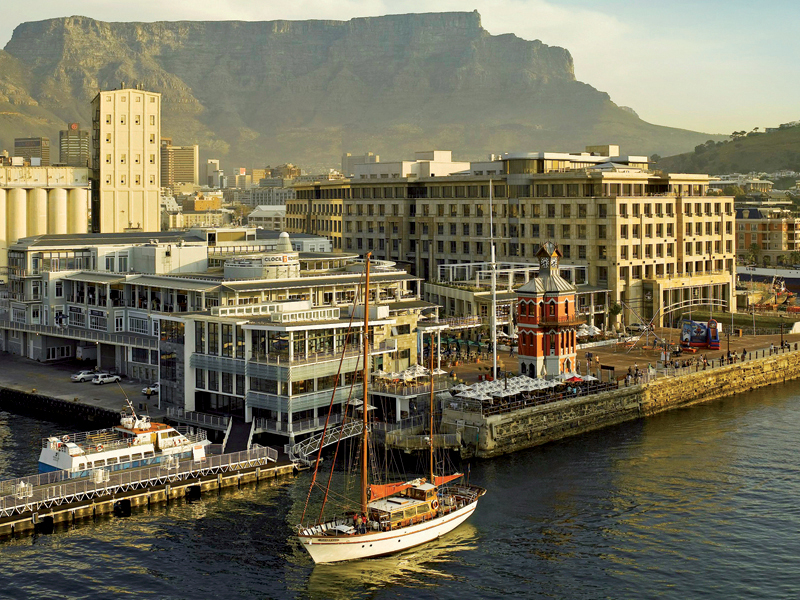
Sample beer from local craft microbreweries such as Triggerfish and Jack Black in the bars around Victoria and Alfred harbour.
CHAD HENNING | GETTY IMAGES ©
GRAIN POWER
Beer was brewed at the Cape one year before the first wine was produced, so it’s only right that locally brewed craft beer is now gaining a huge increase in fans. It’s even got its own language, just like wine: think ‘chewy malt backbone’ or ‘hoppy with nutty overtones’. Banana Jam Cafe in Kenilworth has 10 craft beers on tap, including their own Cream Ale. If you can’t decide, then try the tasting platter of six samples. Boston Breweries Tasting Room in the Cape Quarter offers six brews, from a light Johnny Weiss Gold to their Black River Coffee Stout, via a ‘Naked Mexican’.
■ The Perfect Getaway
Saturday morning sees you at the award-winning Neighbourgoods Market in Woodstock’s Old Biscuit Mill. Breakfast is a mango-and-orange smoothie followed by a Thai scramble, or salmon hollandaise rosti and coffee. Taste as much as possible for free, too, like the biltong (dried strips of salted meat), olives, pesto, cheeses, breads and ice cream. Everything here is made by food artisans, using organic raw materials from local farmers.
Now you’re heading down the peninsula to the Constantia Valley, where you’ll find modern wineries housed in gracious Cape Dutch buildings. Stop off at Klein Constantia, where your tasting might include Jane Austen’s favourite tipple, the dessert wine Vin de Constance. Ready for lunch, you drive over the Table Mountain range to Noordhoek, where Cape Point Vineyards produces ‘cold climate’ wines kissed by sea breezes. Choosing one of their sauvignon blancs, you laze on the lawns with a picnic hamper, enjoying the sea views. Dinner time and you’re back in Woodstock, where the Test Kitchen transforms fresh market produce into an imaginative menu, and every dish is paired with a wine.
Another day, another breakfast, this time at the Loading Bay in De Waterkant, where the homemade breads are baked in a wood-fired oven. Just down the road, the colourful Bo-Kaap area is home to descendants of Malay slaves. Here you join a cooking safari, exploring the spice shops before concocting a Malay lunch. Or you could sample another strand of the cuisine scene: African food offered by migrants from further north, including Mali, Nigeria, Malawi and the Congo. Bebe’s Restaurant in Long St dishes up Cameroonian and Ethiopian soul food.
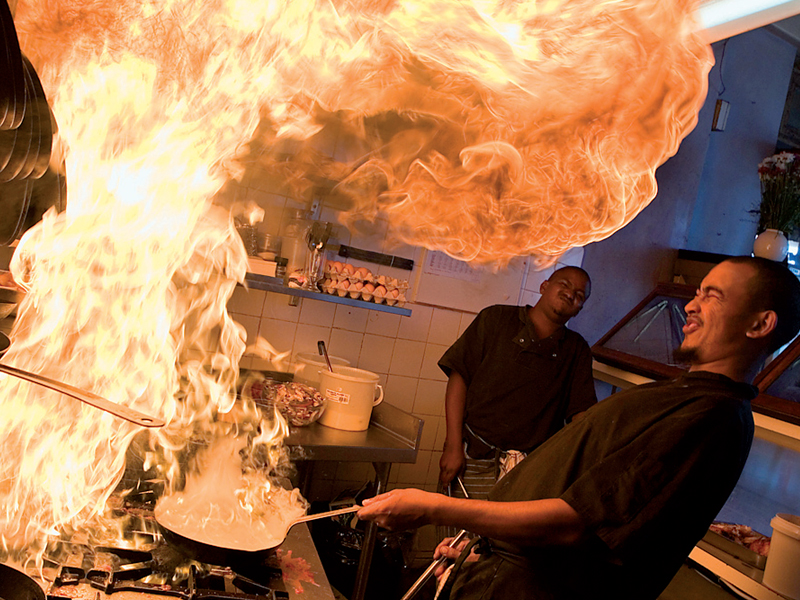
MASSIMO RIPANI/SIME | 4CORNERS ©
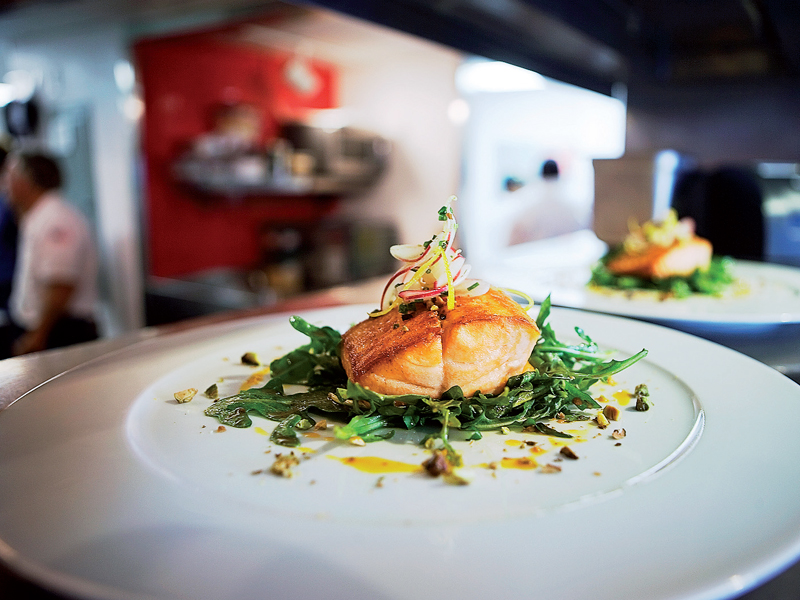
Chefs in Cape Town’s restaurants use local ingredients.
BOUNCE | GETTY IMAGES ©
■ Plan It
Fly into Cape Town International Airport and head for your hotel in the City Bowl, Waterfront or Green Point. Cape Town Tourism can help you find accommodation. The Wine Desk at the Victoria & Alfred Waterfront helps plans tours around wine. You’ll need reservations if you’d like to picnic at a winery, but not for tastings (often subject to a small fee). Look out for the Craft Beer Project in February and the Fresh Wine Festival in March.
■ Detour
Follow your nose to the spices of the Bo-Kaap by trying Andulela’s Cape Malay Cooking Safari. Enjoy a meander around this area, a visit to the museum and shopping for spices, then whip up a traditional Malay lunch. If you are intrigued by Xhosa culture, Andulela also offers an African Cooking Safari in vibrant Gugulethu. For an insight into township life, start with a local tour, then sit down to some serious cooking in a family home. Coffeebeans Routes offers the Cape Town Cuisine Route, visiting home kitchens as well as easy-to-miss markets.
DECKCHAIR
* Grape: Stories of the Vineyards in South Africa (Jeanne Viall et al) A readable, thought-provoking historical account of the development of South Africa’s wine industry.
* Ukutya Kwasekhaya: Tastes from Nelson Mandela’s Kitchen (Xoliswa Ndoyiya) Includes recipes for the umqusho (maize and beans) and umsila wenkomo (oxtail stew) enjoyed by Madiba.
* John Platter Wine Guide (John Platter) Quintessential guide to South African wine. It includes information on the wine routes, too.
* Philida (André Brink) Based on the true story of a slave on the Stellenbosch estate, which became the prestigious Solms-Delta winery of today.
* Reuben Cooks Local (Reuben Riffel) Cape Town’s own celebrity chef tells stories around the recipes that celebrate local produce.
TASTY ADVENTURES IN HOI AN
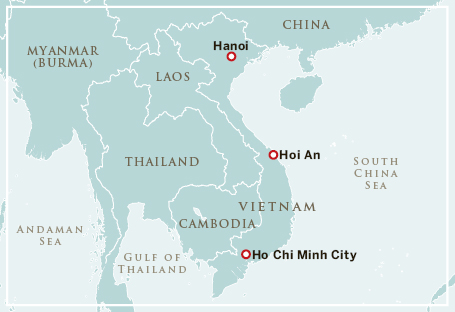
If you’re the sort of traveller who believes that eating locally is one of the best ways to immerse yourself in a culture, prepare to be amazed by Hoi An, Vietnam’s culinary capital.
ESSENTIAL EXPERIENCES
* Watching paper lanterns floating on the water at dusk from the Japanese Covered Bridge.
* Learning to roll chunky noodles for cao lau – Hoi An’s favourite dish – at a cooking school.
* Testing your two-wheel prowess on a motorbike tour around the idyllic back roads of central Vietnam.
* Getting under the skin of Hoi An’s maritime history in the Chinese assembly halls.
* Gobbling down chillies before breakfast on a street-food tour and haggling over freshly caught fish at the morning market.
* Being measured at one of Hoi An’s famous tailor shops (the city has long been known for fabric production).
Eating is a round-the-clock pastime in Hoi An. Dawn breaks, and chefs promptly set up stalls on the town’s streets, dishing up breakfasts of porridge, spicy broths and smoothies to hungry passers-by. By mid-morning, markets fill with customers and local chefs piling high their baskets with fistfuls of aromatic herbs, pungent spices, bundles of vegetables and flapping fish freshly plucked from the surrounding seas.
A sleepy town of boho boutiques and bicycle-clogged thoroughfares, Hoi An has a long and distinguished foodie heritage. In centuries past, merchants from across Asia journeyed to this thriving port to trade in spices, coffee, tea and sugar. They’ve long since set sail, but the recipes they left behind linger on in Hoi An’s cosmopolitan culinary repertoire, which deftly blends Japanese, Chinese and European influences. Furthermore, Hoi An is situated right in the middle of Vietnam – perfectly poised to pick from both the subtler flavours of the north and the fierier cooking traditions of the south.
There’s no better way of getting to grips with Hoi An’s food culture than by taking a cooking lesson here. A number of restaurants offer masterclasses in preparing Vietnamese dishes – think crunchy spring rolls, fragrant curries and steaming pho (noodle soup) – but don’t leave without mastering local stalwarts, too. Look out for cao lau (a Japanese-style noodle dish that tradition dictates must be made using water from a particular well in Hoi An) and banh bao (aka ‘white rose’; fluffy flower-shaped dumplings).
Evening draws in over Hoi An, and belts are loosened a notch or three as diners gorge themselves at restaurants lining the lantern-lit quays. Eventually, diners depart to sip on bia hoi (Vietnamese beer) at roadside stalls, while chefs retire to their kitchens, preparing for another day of serious eating ahead.
LOCATION HOI AN, VIETNAM | BEST TIME OF YEAR FEBRUARY TO MAY | IDEAL TIME COMMITMENT TWO DAYS | ESSENTIAL TIP PLACE FOOD IN YOUR OWN BOWL BEFORE EATING AT MEALS: LIFTING IT STRAIGHT FROM THE COMMUNAL BOWL TO YOUR MOUTH ISN’T SOCIALLY ACCEPTABLE | BUDGET $ | PACK IMODIUM; NOT ALL STREET FOOD IS 100% TRUSTWORTHY!
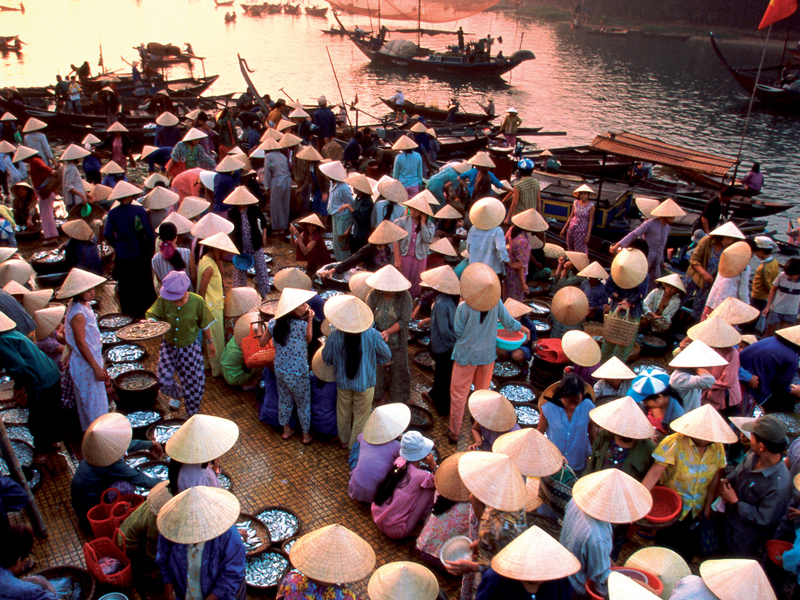
Hoi An’s morning market sees locals select fresh fish straight from the boat.
GLEN ALLISON | GETTY IMAGES ©
A TASTE OF VIETNAM’S CUISINE
Moulded by influences from across Asia and Europe, Vietnamese food is as bafflingly diverse as it is delicious. Hoi An’s most famous dish is cao lau – thick noodles (similar to Japanese soba noodles) paired with pork and greens. Venture north of Hoi An and you’ll soon encounter Vietnam’s most exported dish: pho bo (beef noodle soup). Go south, and you might happen across canh chua ca, a sour fish soup from the Mekong Delta with generous quantities of vegetables and herbs. Also in the south, Ho Chi Minh City (Saigon) has a wide variety of banh mi – a short baguette sandwich inherited from French colonial rule, potentially containing anything from sausages to sardines.
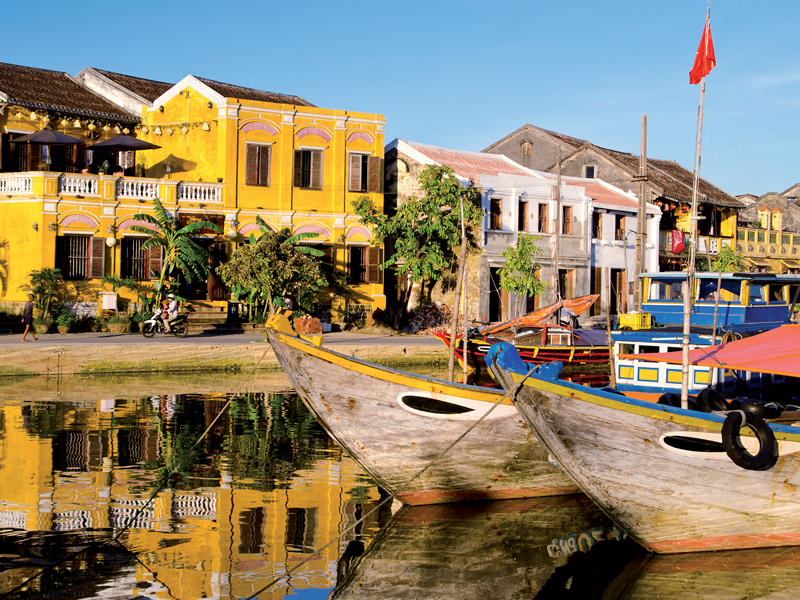
Hoi An was built on the banks of the Thu Bon river.
MEGAN AHRENS | GETTY IMAGES ©
TAMING THE DRAGON
According to legend, Hoi An’s 16th-century Japanese Covered Bridge wasn’t just built for crossing from one side of the water to the other. The Japanese community in Hoi An believed in a gigantic subterranean dragon who caused earthquakes and other unfortunate events every time he shifted his body weight about. Reasoning that his head was in India and his tail in Japan, they decided the bulk of the dragon must be located in Vietnam, and resolved to pin him down and prevent further tragedies by constructing this bridge. A small temple on the north side of the bridge was built by sympathetic locals to pray for the unfortunate dragon’s soul.
■ The Perfect Getaway
On top of its foodie pedigree, Hoi An can claim to be Vietnam’s most beautiful city, with leafy streets of mustard-yellow townhouses and mahogany-shuttered shopfronts and a sublime riverside setting. Begin your culinary adventure by rising early to join a street-food tour and see the Old Town ahead of the crowds. The Original Taste of Hoi An offers encyclopedic tours of stalls, where you’ll meet vendors serving banh mi and Hoi An–style wonton pancakes before signing off with a comprehensive tasting session at lunchtime.
Afterwards, walk off your lunch with a tour of the town’s magnificent assembly halls – originally built by Chinese merchants who sailed to Hoi An in its 17th-century heyday. The most elaborate is the marshmallow-pink Fujian assembly hall, containing model boats and murals of Chinese sailors journeying homeward through stormy seas. Spend the rest of the afternoon on a motorcycle tour exploring the patchwork of rice paddies and meandering canals around Hoi An.
Back in Hoi An, book a table for dinner at Lantern Town, a restaurant in a breezy colonial-era building, where seafood figures prominently, or for something more contemporary opt for Green Mango’s French-accented dishes. On an evening stroll along the waterfront you’ll pass fishing boats creaking at their moorings and paper lanterns drifting serenely in the current, before arriving at the 16th-century Japanese Covered Bridge – Hoi An’s famous landmark.
The next morning, pay a visit to Gioan, which runs the liveliest cooking courses in town. After buying materials at a market and sizzling them down to size, you’ll leave with a cookbook to add a pinch of Hoi An pizazz to your own kitchen.

ANDERS BLOMQVIST | GETTY IMAGES ©
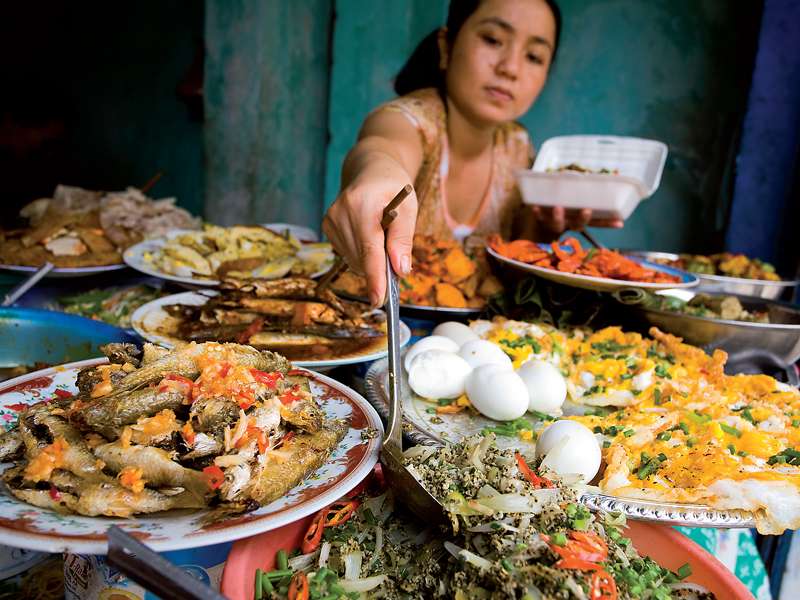
Whether you sit down at a restaurant in an old colonial building or graze from street-food stalls, Hoi An will thrill your tastebuds.
PETER STUCKLINGS | GETTY IMAGES ©
■ Plan It
The easiest way to get to Hoi An is via the seaside resort of Danang, 30km to the north; buses take an hour. A few airlines operate direct flights to Danang from major Asian cities. Vietnam Airlines offers flights from hubs in Europe and elsewhere in Asia, changing at Ho Chi Minh City or Hanoi. Danang is also a stop on Vietnam’s North–South Railway, with trains running from Ho Chi Minh and Hanoi.
■ Detour
An hour or so to the north, Hue is Hoi An’s main contender for Vietnam’s culinary crown. A stately city of palaces and pagodas, Hue became the capital of Vietnam under the Nguyen dynasty, with royals recruiting an army of chefs from across the country to prepare extravagant banquets in their honour. Fast-forward a century or two, and restaurants keep the spirit of the imperial banquets alive, serving dishes sculpted into weird and wonderful shapes. If you’d prefer something a bit more humble, however, head to the city’s Dong Ba Market to pick up Hue’s signature pancakes – banh khoai.
DECKCHAIR
* The Quiet American (2002) Despite being set in Saigon (Ho Chi Minh City), the most recent adaptation of Graham Greene’s novel was partly filmed in Hoi An.
* Vietnamese Street Food (Tracey Lister and Andreas Pohl) A street-food photo odyssey of Vietnam, with easy-to-follow recipes.
* The Songs of Sapa (Luke Nguyen) Australian-Vietnamese chef Luke Nguyen does justice to the diversity of Vietnamese cooking.
* Vietnam: Rising Dragon (Bill Hayton) BBC correspondent Bill Hayton’s take on the economic and political challenges facing modern Vietnam.
* Dispatches (Michael Herr) A visceral first-hand account of the Vietnam War by Esquire reporter Michael Herr.
* A Dragon Apparent: Travels in Cambodia, Laos and Vietnam (Norman Lewis) A classic of travel writing from the 1950s.
PUGLIA ON A PLATE: INSIDERS’ ITALY
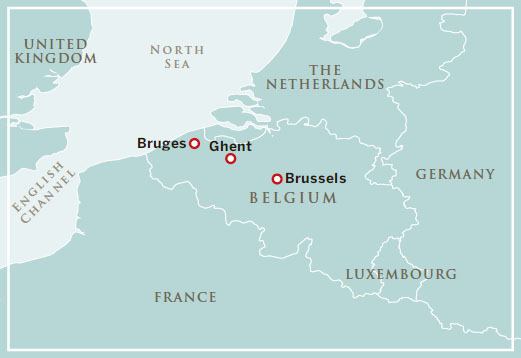
Ever wondered what’s in the heel of Italy’s boot, or where Italians holiday in the summer? On both counts it’s Puglia, with its silk-white beaches, ancient towns and fresh produce and fine wines.
ESSENTIAL EXPERIENCES
* Floating in the warm, translucent sea beside a glimmering white beach.
* Attending a sagra (food festival) paying tribute to a local foodstuff, such as snails, sea urchins or bread.
* Dancing to the pizzica music in a small-town piazza, the band playing on a bandstand blazing with light bulbs.
* Eating the traditional pasta of the region, orecchiette (meaning ‘little ears’), washed down with local wine, and followed by a glass of homemade limoncello (lemon liqueur).
* Taking a passeggiata (early-evening stroll) along the promenade in any of Puglia’s seafront towns.
* Enjoying the rustic, sun-bleached setting and the curious architecture of the local trulli farmhouses.
Come July and August, Italian families from all over the country pack up their bags and start for the south. It’s time to celebrate the glorious, long Italian summer. August is so reliably sun-baked that many restaurants and businesses around the country simply shut up shop, with signs on the doors reading: ‘gone to the beach, back in September’.
Whatever Italy’s economic and political ups and downs, there’s always the south, with its forget-your-cares beaches, a fierce sun in a cloudless sky, and delicious food fished fresh from the sparkling sea or grown and sun-ripened and brought from the field to your table. It was only recently that the rich and varied region of Puglia came to the attention of foreign tourists, and it still feels undiscovered. It’s difficult to say what it was that first grabbed people’s attention. Was it the white town of Ostuni, which shimmers on its hilltop, visible for miles? Was it honey-hued Lecce, a historic university city, with its baroque style?
No, it must have been the beaches, which can feel closer to the Caribbean than the Mediterranean, such is the clarity of the water and the softness of the white sand. They get full to bursting in July and August, but there is an advantage to coming here in peak time: it’s festival season. Every night at least a few towns kick up their heels with free music festivals playing the traditional music of the pizzica, the Pugliese folk dance.
July and August may be when everyone in Italy heads to Puglia, but you don’t have to come here then. In May, June and September, the sea is warm, prices are lower, businesses are still open, and the beaches are almost deserted. Come out of season, but when the weather’s still balmy, and you’ll have an entirely different kind of holiday: a tranquil meander around the towns and countryside, and all those white-sand expanses almost entirely to yourself.
LOCATION PUGLIA, ITALY | BEST TIME OF YEAR MAY TO SEPTEMBER | IDEAL TIME COMMITMENT ONE TO THREE WEEKS | ESSENTIAL TIP ITALIANS TAKE THEIR HOLIDAYS IN JULY AND AUGUST, SO IT’S BUSIER, PRICIER AND HOTTER IN THESE MONTHS | BUDGET $$ | PACK AN APPETITE: PUGLIA IS FAMOUS FOR ITS FOOD

A trio of trulli: once dry-stone-built shelters or storehouses, Puglia’s unique dwellings are fast becoming boutique hotels.
PICCERELLA | GETTY IMAGES ©
CASTLES
Facing the Adriatic and Ionian Seas, Puglia had an essential strategic position as the stepping stone to the eastern Mediterranean. Greeks, Romans, Saracens, Aragons, Normans and Swabians have all made their mark here, and the coastline and landscape is marked by impressive fortifications and walled townscapes. Most extraordinary is the geometric perfection of the middle-of-nowhere octagonal Castel del Monte, built in 1240 by Holy Roman Emperor Frederick II. Frederick left the most significant fortresses in the region, building and rebuilding castles at Oria, Trani and Bari, among others – great squared-off edifices that speak of the region’s embattled past.
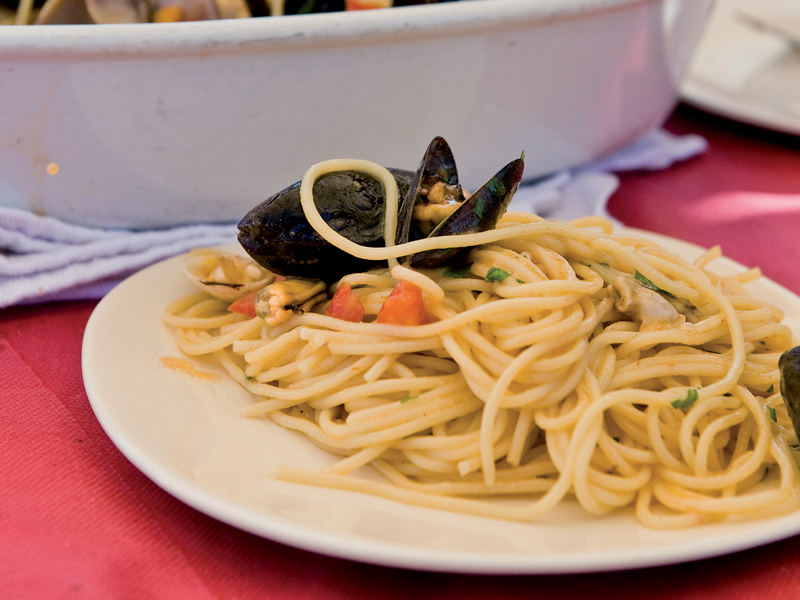
Fresh seafood, handmade pasta and a dash of local olive oil: good food is simple in Puglia.
DANIEL REITER/STOCK4B | GETTY IMAGES ©
PUGLIESE CUISINE
Pugliese cuisine is born out of cucina povera (‘cooking of the poor’; peasant food), with unique dishes that merge bountiful local fresh vegetables and straight-from-the-sea fish. Specialities include the glorious comfort food riso, patate e cozze (rice, potatoes and mussels), taralli (a kind of hard Italian pretzel) and friselle (dried bread rolls softened with olive oil and served topped with tomatoes, which were once the easy-to-carry food of farm workers). The iconic pasta is orecchiette, small ear-shaped pasta hand-made without the addition of egg, while one of the most divine local concoctions is burrata – a kind of mozzarella that, when you cut into it, oozes fresh cream: the food of the gods.
■ The Perfect Getaway
In one of Puglia’s prettiest regions, the rolling Valle d’Itria, you’ll spot curious, circular stone houses dotting the countryside, their white-tipped roofs tapering up to a stubby point. These are trulli, Puglia’s unique rural architecture. Many of the trulli today have been converted into remarkably serene boutique hotels and villas. The rustic architecture is often merged with a contemporary aesthetic, while the surrounding grounds are shaded by a tangle of olive, orange, lemon, walnut and hazelnut trees, and overgrown cacti laden with prickly pears. Seek out a place with a swimming pool, as you’ll need somewhere to escape the heat.
Any of the hilltop towns in the Valle d’Itria are worthy of a visit, including Ostuni, Cisternino and Martina Franca, which are also gaining fame for their wine. Farther south, in the charismatic, Greek-flavoured region of Salento, the most beautiful towns are Lecce, with its impressive churches and cathedral, and the seaside, fortress-dominated escapes of Otranto and Gallipoli. Beaches in this region include the brilliant-blue-meets-white Baia dei Turchi and Melendugno.
If you head south to Santa Maria di Leuca, a heart-in-your-mouth drive along an epic rocky coast, you’ll spy deserted towers where locals once kept a watch to warn of the regular invasions from the east. Alternatively, head north along the coast to the elegant coastal town of Trani, whose waterfront cathedral has the sea lapping at its foundations. Beyond here is Puglia’s Gargano Peninsula, which feels closer in spirit to the rocky, vegetation-covered Croatian coast (to which it was once joined) than to elsewhere in Puglia. It’s a greener coastline, with more long sandy beaches: a magnet for Italians in summer and dotted by pretty towns.
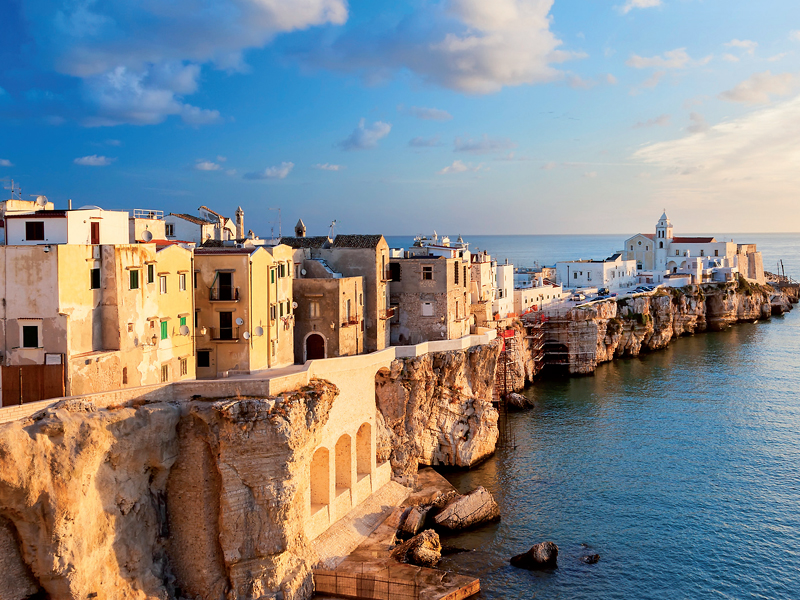
The town of Vieste stands on the Promontorio del Gargano.
PETER ADAMS | GETTY IMAGES ©
■ Plan It
The airports at Bari and Brindisi have domestic connections, plus flights from European cities. Once in Puglia, car hire is advisable, though there are train and bus connections. If travelling in July and August book ahead for accommodation. For families and groups of friends, self-catering villas and agriturismi (farmstays) are the best bet, but for couples there’s an excellent choice of boutique hotels too, particularly around Fasano.
■ Detour
If you enjoyed your Puglian sojourn, try nipping next door to Basilicata. Francis Ford Coppola’s family originates from this out-of-the-way region, where the film director owns an exquisite hotel, Palazzo Margherita, in the village of Bernalda. Rivalling the Amalfi, a stretch of coast by Maratea has a roller-coaster road that passes turquoise sea and volcanic-sand beaches. But Basilicata’s most alluring place is the extraordinary town of Matera, built across a network of caves. Integrated into townhouses, the caves now house some of Italy’s most unique hotels.
DECKCHAIR
* Reasonable Doubts (Gianrico Carofiglio) Written by an anti-Mafia prosecutor, this thriller follows Guido Guerrieri, a defence counsel, who takes on the case of a Pugliese drug smuggler.
* The Past is a Foreign Country (Gianrico Carofiglio) Winner of the Premio Bancarella award; another tense psychological thriller by Carofiglio, based in Bari.
* Puglia: A Culinary Memoir (Maria Pignatelli Ferrante) Recipes, anecdotes and history combine in this evocation of the local cuisine.
* The Castle of Otranto (Horace Walpole) Generally regarded as the first-ever Gothic novel, this 1764 novel is set against an Otranto backdrop.
* Christ Stopped at Eboli (Carlo Levi) Set in Basilicata, this tale of Levi’s time in exile (imprisoned by the Fascists) is a classic account of southern Italian small-town life.
HAWKER-FOOD HEAVEN IN PENANG
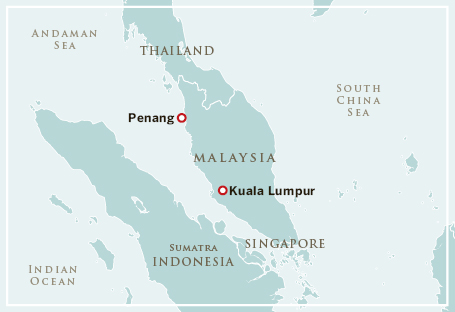
Arrive on an empty stomach and graze at will: between outrageously good hawker food and a burgeoning handful of modern restaurants, Penang is one of the planet’s best escapes for food-obsessed travellers.
ESSENTIAL EXPERIENCES
* Negotiating a tasty path around Penang’s hawker centres – ask locals for their recommendations on the best char kway teow or asam laksa in town.
* Sampling regional dishes – Chinese, Indian, Malay and Nyonya – in the compact and bustling cafes of Chinatown and Little India, and around Gurney Drive and Jalan Burmah.
* Exploring George Town’s compelling overlap of different ethnic groups and cultures.
* Finding relief from Penang’s tropical heat amid the ornate interiors of the former mansions of Chinese millionaires and Peranakan merchants.
* Staying in one of the boutique hotels housed in Penang’s restored colonial buildings, such Muntri Mews or Mango Tree Place.
People come to the Malaysian island of Penang just to eat. Even if you thought you came here for another reason, your priorities might change dramatically once you start digging into the Indian, Chinese, Malay and various hybrid treats available. Days revolve around where and what to eat, and three meals a day starts to sounds depressingly scant. It’s the same for locals, for whom eating out is a daily event.
In the island’s compact capital of George Town, centuries of immigration and trade interact to create culinary shifts within a few minutes’ walk. Sleepy Chinatown laneways are resurrected at dawn as busy dim sum eateries, crammed in the diffuse tropical light with loyal regulars. Head a few blocks southeast to Little India for breakfast, and the tropical humidity is alleviated by softly spinning ceiling fans and refreshing glasses of teh tarik (pulled tea).
Penang’s famed hawker centres become the focus later in the day, with legions of long-established stalls turning out dishes imbued with culinary clues from India, the Malay peninsula and many Chinese provinces. When Hokkien settlers from Fujian province took local wives several centuries ago, Peranakan food (also known as Nyonya food) evolved through the marriage of Chinese and local flavours. One of the planet’s first fusion cuisines, it combines Chinese staples like soy sauce and tofu with tropical ingredients like lemon grass, coconut and galangal; the tamarind-heavy asam laksa is an essential Penang hawkers’ dish.
An almost perverse obsession with food among the locals means that visitors are often smothered in culinary companionship; the traveller who makes the effort to partake in the region’s edible delights will undoubtedly make a few makan kaki (food friends) along the way. Simply put, in this part of the world it’s not ‘How are you?’ but Sudah makan? (Have you eaten yet?)
LOCATION PENANG, MALAYSIA | BEST TIME OF YEAR DURING JULY’S GEORGE TOWN FESTIVAL OR FOR ONE OF PENANG’S CULTURAL FESTIVALS | IDEAL TIME COMMITMENT AT LEAST THREE DAYS TO SAMPLE THE CULINARY DIVERSITY | ESSENTIAL TIP VEGETARIAN OPTIONS ABOUND | BUDGET $$ | PACK A CULINARY SENSE OF CURIOSITY
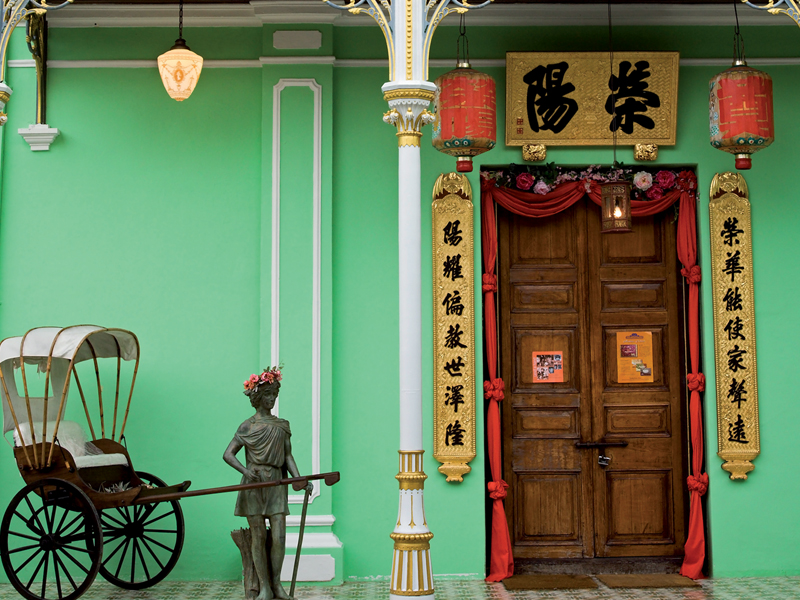
Pinang Peranakan Mansion has been restored to show how wealthy Chinese emigrants lived in 19th-century Penang.
ANDERS BLOMQVIST | GETTY IMAGES ©
HERITAGE HOTELS
Architecturally, Penang’s cultural and historic DNA has left much for modern travellers to explore. Most famous is Cheong Fatt Tze Mansion, the 38-room former residence of a penniless Chinese immigrant who rose to become one of Asia’s most wealthy men. Combining a rich cobalt exterior and an eclectic and elegant interior, the 1880s mansion is almost luminous. Other ornate buildings reflecting Penang’s history of wealth and influence include the Khoo Kongsi clanhouse and the Pinang Peranakan Mansion; the British colonial era is reflected by the stately Eastern & Oriental Hotel. Following George Town’s inscription as a Unesco World Heritage Site in 2008, the city’s celebrated townscape is now protected, and boutique hotels are opening in restored colonial shophouses and mansions.
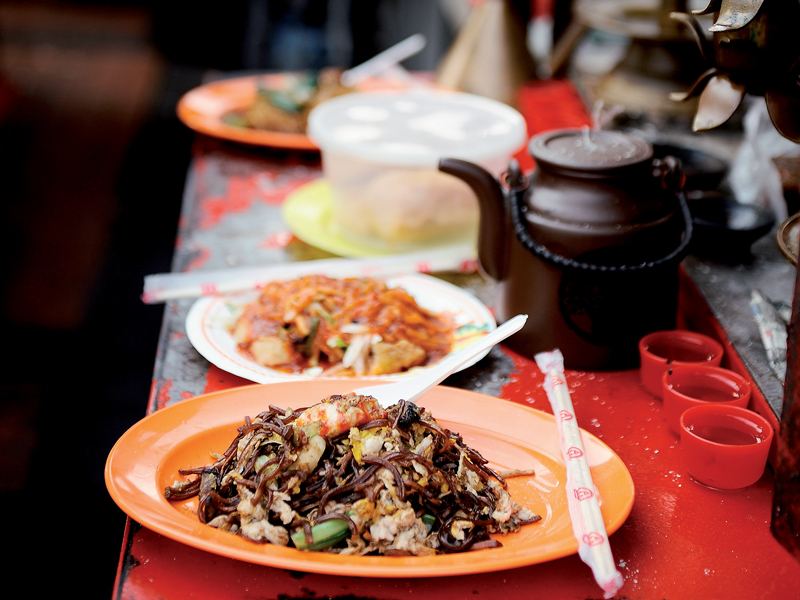
Sampling street food, such as char kway teow.
CARLINA TETERIS | GETTY IMAGES ©
CLASSIC PENANG DISHES
Penang’s riot of hawker centres can create havoc for the indecisive visitor. Order the following to make tasty sense of the island’s culinary collage: char kway teow (flat rice noodles with shrimp, bean sprouts, egg and sweet Chinese sausage), Hokkien mee (egg noodles in a pork broth with prawns, egg, bean sprouts and water spinach), asam laksa (thick white noodles in a spicy fish broth punctuated with tangy asam, a sour tamarind paste), cendol (shaved ice with mung-bean noodles, coconut milk and palm sugar) and lau hao (a refreshing nutmeg juice sweetened with Chinese sour plum).
■ The Perfect Getaway
Begin your culinary adventures in George Town by heading to Little India on your first morning and breakfasting on super-flaky roti canai (layered flatbread) at Special Famous Roti Canai on Jalan Transfer. After getting agreeably lost amid Little India’s colourful labyrinth, continue to the art galleries and restored shophouses on nearby Lebuh Armenian. Recharge with lunch and a lassi or fresh juice at the tiny Amelie before entering the dramatic Khoo Kongsi, an elaborate clanhouse for the Chinese Hokkien community. For dinner, visit the sprawling Esplanade Food Centre, where hawker food favourites and Penang’s cheapest and coldest beer combine with a seafront location. Finish with a George Town nightcap in the colonial ambience of Farquar’s, at the Eastern & Oriental Hotel.
The next morning breakfast on dim sum at Tho Yuen on Lebuh Campbell in Chinatown. Try the lo mai gai (sticky rice with chicken, mushroom and Chinese sausage). After breakfast, spend your morning exploring Chinatown, stopping for refreshment at hole-in-the-wall tea shops and taking a guided tour of Cheong Fatt Tze Mansion. Then arrive at noon to secure a table for lunch at the popular Teik Sen on Lebuh Carnarvon. A few interesting streets to the east, negotiate a path around Penang’s colonial district, stopping at Fort Cornwallis, the Pinang Peranakan Mansion and the Penang Museum. Dinner is your chance to sample some of Penang’s best Nyonya food at Nyonya Breeze on Lorong Abu Siti. Order a glass of lau hao (nutmeg juice) to soothe dishes like kari kapitam (chicken curry). Spend your third morning at a cooking class with Nazlina’s Spice Kitchen: here’s your chance to recreate Penang’s spicy culinary blend for yourself.

Making nasi lemak, rice steamed in coconut milk and served with a hot sambal.
MATTHEW WAKEM | ROBERT HARDING ©
■ Plan It
Penang is reached by flights from Kuala Lumpur, Singapore and Bangkok. Ferries make the hop from Penang’s capital of George Town to Butterworth, which has road links to Singapore and Kuala Lumpur, and the 13.5km-long Penang Bridge, which links the island to peninsular Malaysia. For a full immersion into Penang’s culinary melting pot, book early to visit during one of the festivals: the Tamil celebration of Thaipusam, the Chinese Hungry Ghost Festival or the Hindu festival of Deepavali.

Sampling street food, such as char kway teow.
TIBOR BOGNAR | ALAMY ©
■ Detour
Divert northeast to Hanoi for Asia’s other great street food destination. Vietnamese, Chinese and colonial French culinary influences underpin the rustic dining experiences dotted throughout the city’s labyrinthine Old Quarter. The Vietnamese capital’s best food is dished up by vendors crowding the sidewalks with smoking charcoal burners, tiny plastic stools and queues of expectant locals. Many stalls have been operating for decades, and offer just one perfectly-executed dish.
DECKCHAIR
* Cradle of Flavor: Home Cooking from the Spice Islands of Indonesia, Singapore, and Malaysia (James Oseland) A beautiful tome covering the foods of Malaysia and its neighbours.
* The E&O Hotel: Pearl of Penang (Isla Sharp) The illustrated history of Penang’s most famous colonial hotel.
* Penang: Through Gilded Doors (Julie de Bierre) More stunning photographic evidence of Penang’s architectural heritage.
* Leaving the Heart Behind (Joan Foo Mahoney) Two families and two cities – Penang and Tokyo – are showcased in this novel spanning four decades from 1936.
* The Gift of Rain (Tan Twan Eng) A tale of loyalty set in Penang, leading up to the Japanese occupation in late 1941.
* Indochine (1992) Catherine Deneuve swans around colonial Vietnam, but Cheong Fatt Tze Mansion is used for many interior scenes.
CHILE’S GRAPE ESCAPES
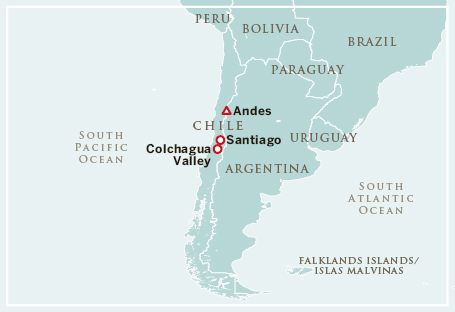
You’ve had a nip in the Napa Valley and you’ve imbibed in Bordeaux – but have you ever sipped some of the world’s best red wines in the shadow of the Andes?
ESSENTIAL EXPERIENCES
* Wandering through the Museo Colchagua and taking in thousands of years of ancient history.
* Sampling wine, wine and more wine in some of the region’s 26 vineyards.
* Trying the local Chilean cuisine at a restaurant in Santa Cruz, one of the area’s more charming towns.
* Riding the gondola at Vina Santa Cruz and walking through the pavilions dedicated to three of the area’s ancient cultures.
* Star-gazing at Vina Santa Cruz, or just marvelling at the winery’s meteorite collection.
‘God was bringing the devil in his luggage.’
So says Pablo, the tour guide at Vina Santa Cruz, as he strolls through the vines clinging to the rolling hills. He’s referring to an old saying in Chile, used to describe how wine ended up in these parts. It was brought here by missionaries, Pablo says, to be used during mass as they sought to convert the locals. However, those locals showed just as much passion for the wine as they did the religion. And so here we are today, surrounded by hectare after hectare of grapes, with the Andes soaring high above on the horizon. Wine isn’t the devil anymore – instead, it’s a booming industry, and one Chileans are justifiably proud of.
This is the Colchagua Valley, one of Chile’s premier wine-producing areas and a short drive south of Santiago. The area is famous for its cabernet sauvignon, which explains the fat bunches of ruby-red grapes hanging from the rows of vines that stretch as far as the eye can see. People come to Colchagua to try the wine – though it’s mostly local Chilean tourists, as the area isn’t widely visited by international travellers. But there are other reasons to come here. For example, how many vineyards have you been to that have both a DeLorean and a llama?
This is Vina Santa Cruz, home to 180 hectares of vines, and the aforementioned car and animal. The car – a replica of Marty McFly’s time machine from the Back to the Future films – is in the display room and it’s as popular with kids as the wine is with their parents. The llama is up on top of a hill. When the tour of the winery concludes, Pablo points up to that summit. ‘We’ve seen the heart of our wine,’ he says. ‘Now let’s go and see its soul.’ Up top are three pavilions, each dedicated to an ancient culture that left its mark on Chile: the Mapuche, the Aymara and the Easter Islanders. It’s a nice tribute to the land’s former owners – the ones who were here before the devil arrived in God’s luggage.
LOCATION COLCHAGUA VALLEY, CHILE | BEST TIME OF YEAR HARVEST (MID-MARCH UNTIL THE END OF APRIL); WINERIES ARE OPEN YEAR-ROUND | IDEAL TIME COMMITMENT THREE DAYS | ESSENTIAL TIP ORGANISE A WAY BACK TO YOUR HOTEL BEFORE GOING TO THE WINERY: TAXIS ARE SCARCE IN SANTA CRUZ | BUDGET $ | PACK A JUMPER; TEMPERATURES DROP QUICKLY AT NIGHT

Haras de Pirque vineyard is in the Maipo Valley, the wine-growing region closest to Santiago.
HOBERMAN COLLECTION/CONTRIBUTER | GETTY IMAGES ©
HOW WINE CAME TO CHILE
Blame the missionaries. When Spanish conquistadores decided to have their way with Chile, it opened the door for missionaries to begin preaching the good word. In order to conduct Mass the missionaries needed wine, which prompted Diego García de Cáceres to plant the first vines in Santiago in 1554. By the 1800s the vineyards had grown from supplying merely the local Sunday Mass to exporting their product to Europe, and production peaked just before WWII. These days the industry has been scaled back slightly, but the country is still well known for its top-quality cabernet sauvignons.

Aging gracefully: barrels of wine in the cellar of Los Robles winery in the Curicó Valley.
STEVEN MORRIS PHOTOGRAPHY | GETTY IMAGES ©
PISCO INFERNO
While Chile is known around the world for its wine, local residents are even more passionate about another grape-based tipple: pisco. Produced in the vine-growing regions north of Santiago, pisco is a type of grape-based brandy whose native origins are fiercely fought over by Chile and neighbouring Peru. Regardless of where it started, Chileans consume plenty of pisco, particularly in the famous cocktail the pisco sour – a mix of pisco, egg whites, sugar syrup, lime juice and bitters. If you want to try the very best, keep your eye out for Gran Pisco, the most sought-after (and most alcoholic) version of the spirit.
■ The Perfect Getaway
Wine is undoubtedly the winner here. From the cabernet sauvignons to carménères, merlots and syrahs, there’s something to suit almost every taste in reds. It’s worth planning to visit at least four or five wineries during a trip to the Colchagua Valley, all of which can be reached from a base in the Spanish colonial town of Santa Cruz. The Vina Santa Cruz winery is an undoubted attraction, with its gondola, cultural exhibits and observatory, which houses the largest private meteorite collection in Latin America.
For pure liquid enjoyment, however, cast your net further afield. Most wineries in Colchagua are family-owned, including Viu Manent and Neyen de Apalta, and Vina Montes is a definite highlight of the area. Once the tasting is over, or maybe before it begins, there’s plenty to keep visitors occupied in the town of Santa Cruz. The city’s main square is the perfect spot to wander around for an hour or so, and the streets are filled with traveller-friendly shops.
Perhaps the town’s centrepiece, however, is Museo Colchagua, named the best private collection in South America. The museum houses a dazzling array of artefacts, from million-year-old fossils and Incan pottery, and Spanish colonial carriages to steam locomotives and a curious collection of Nazi memorabilia. One of the newer sections is dedicated to the 2010 Chilean mining disaster (when 33 miners were trapped underground for 69 days), with a recreation of events housed in a full-scale model of the chamber in which the men were trapped.
You could easily spend a whole day here taking it all in. Except, of course, you’d be missing out on all that wine tasting.

HOBERMAN COLLECTION/CONTRIBUTOR | GETTY IMAGES ©
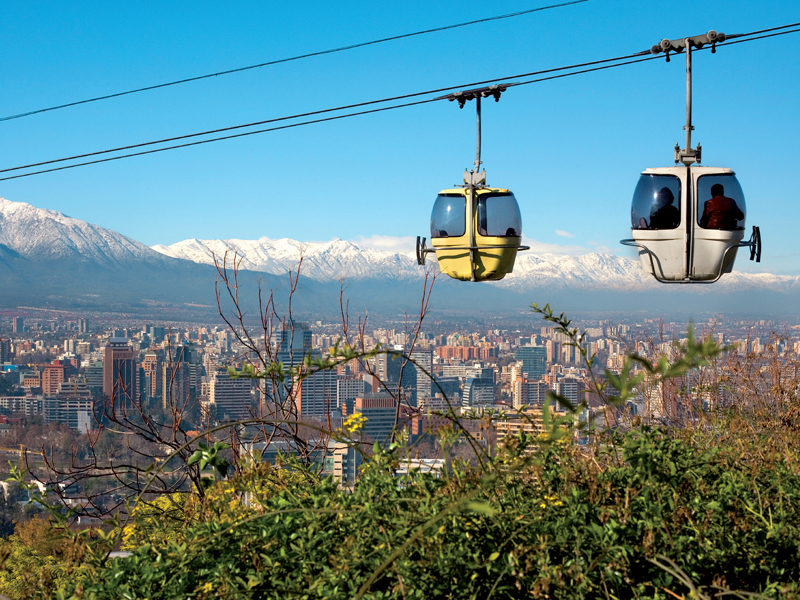
The city stands in the foothills of the Andes at an ideal altitude for ripening grapes.
MARTIN BERNETTI/STAFF | ISTOCKPHOTO ©
■ Plan It
It’s possible to visit Colchagua Valley as a day trip from Santiago, and plenty of companies offer that service. A more enjoyable way to see the valley, however, would be an overnight tour, giving you the chance to sample some of the region’s cuisine over dinner. Those looking for a more independent experience can take a bus from Santiago down to Santa Cruz and hire a car to make their own way through the vineyards. Although an organised tour will allow you to enjoy more of the product on offer.
■ Detour
There’s no need to go all the way to the source to sample Chilean wines – Santiago boasts an appealing array of restaurants and wine bars that stock the local drop. The suburb of Bellavista, the city’s creative hub, is home to its best dining. Try Restaurante La Pescadería, a seafood joint with a long wine list. In Santiago’s old centre, Bocanariz has more than 300 Chilean wines on offer, with 35 by the glass. Over in upmarket Providencia Baco’s modern cuisine is a local favourite.
DECKCHAIR
* By Night in Chile (Roberto Bolaño) A dying priest’s rantings form a chilling indictment on Chile’s brutal Pinochet regime in this novel by one of the country’s foremost writers.
* After-Dinner Declarations (Nicanor Parra) Chileans are famously passionate about poetry, and Parra is the country’s latest darling.
* La Buena Vida (The Good Life; 2008) Chilean filmmaker Andres Wood’s story of four characters struggling through life in Santiago.
* Sideways (2004) It’s not about Chile, but this American cult classic will put you in the mood for wine tasting.
* Se Arrienda (For Rent; 2005) Alberto Fuguet’s acclaimed movie follows the life of a fictional composer in Santiago.
* The Motorcycle Diaries (Ernesto ‘Che’ Guevara) Che Guevara’s tale of adventure and transformation will be enough to stir anyone’s passion for life on the road in South America.
TAKING TEA IN SRI LANKA
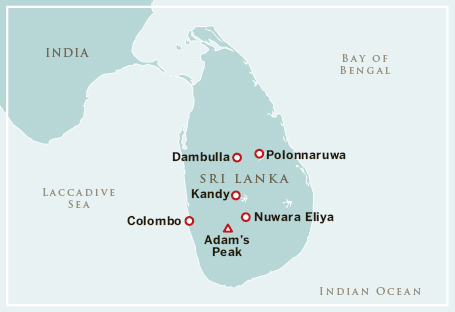
Mist-shrouded mountains and emerald-green tea fields form the backdrop for Sri Lanka’s Hill Country, where the hedonistic days of British colonialism can still be glimpsed in elegant bungalows, pandering butlers, and gin and tonics at sundown.
ESSENTIAL EXPERIENCES
* Tea tasting and a guided tour at the historic Norwood factory.
* Sipping a gin and tonic on the verandah while dusk falls over the mountain landscape.
* Cycling between Ceylon Tea Trails’ four colonial-era planters’ bungalows.
* Dining on tea-inspired cuisine at the villa’s communal table.
* Soaking in a green-tea bath – it’s good for the skin as well as the tastebuds.
* Climbing Sri Pada during pilgrimage season, timing your ascent to arrive at sunrise.
Taking tea is an art form in the Hill Country of Sri Lanka, a verdant, high-altitude region in the heart of the nation. Home to mist-covered mountains and mirror-flat lakes, this lofty location has long been a favourite destination for Sri Lankan high society. In the past, expat tea-planters made their homes here, and each summer Colombo’s leading families fled the city’s humidity for these cool climes. Today, the days of the Raj seem to linger on, with polo grounds, golf clubs and lavish bungalows set in English-style gardens. Terraced hillsides are covered in a carpet of emerald-green camellia bushes, punctuated by the colour-pop of sari-clad women who move through the waist-high shrubs with a peaceful rhythm. For hours each morning, they pluck the tender, top-most leaves and buds, tossing them into a basket slung over their backs.
From these hand-picking methods to the colonial-era factories dotted among the Brit-named towns (think Aberdeen, Norwood and Hatton), much remains unchanged since tea was introduced in the mid-1800s. A tour of the 1830s-era Norwood factory brings the history of Sri Lanka’s tea production to life, as Andrew Taylor, the grandson of James Taylor – the man credited with bringing tea to Sri Lanka – waxes lyrical on the wonders of tea. After touring the roasting and rolling rooms, groups are guided upstairs to the drying area, an open-sided space where tonnes of freshly picked tea leaves have been fanned across tables. As warm air circulates through the greenery, the space is filled with one of the most divine scents you’re ever likely to sniff. Elizabeth Arden, eat your heart out.
At a tea-tasting session, guests smell, swirl and sip their way through different brews sourced from the region, noting citrus flavours, golden hues, smoky characteristics and those astringent tannins that cause your mouth to pucker. After Taylor’s tutorial, your afternoon cuppa will never taste the same again.
LOCATION BOGAWANTALAWA VALLEY, HILL COUNTRY, SRI LANKA | BEST TIME OF YEAR DRY SEASON (JANUARY TO APRIL) FOR SRI PADA PILGRIMAGES | IDEAL TIME COMMITMENT THREE DAYS | ESSENTIAL TIP APPLY FOR A VISA PRIOR TO ARRIVAL | BUDGET $$ | PACK BRING BOOTS AND HIKING KIT FOR SRI PADA, AND A PASHMINA TO KEEP OUT THE MOUNTAIN CHILL

A hard job: tea pickers working in the plantations of Nuwara Eliya.
GAVIN HELLIER | GETTY IMAGES ©
COFFEE OR TEA?
In the early 1800s, the Hill Country’s colonial settlers cleared the jungles and planted coffee trees, only to have the crop wiped out some 40 years later after a fungus infection spread across the countryside. Faced with a huge loss of revenue, a few brave planters, including James Taylor, heard about tea-growing in similar conditions in India. Taylor embarked on a trip to Assam in northern India, returning with seeds for the tea bushes that now proliferate throughout the region. The Taylor family is credited with bringing tea to Ceylon, igniting one of Sri Lanka’s main industries.
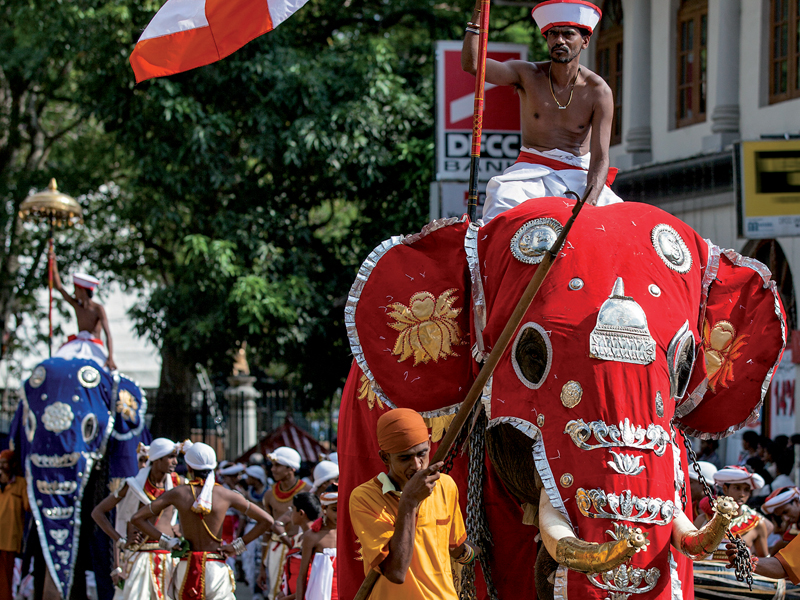
Elephants parade in the Buddhist festival of Esala Perahera in Kandy.
JASON EDWARDS | AWL-IMAGES ©
ASCENDING ADAM’S PEAK
Tea-fiends aren’t the only ones to journey to the Hill Country. From January to April, travellers descend on the region to climb Sri Pada, Sri Lanka’s most sacred mountain. Also known as Adam’s Peak, depending on your religious persuasion the mountain is said to have the footprint of Buddha, Shiva or Adam at its summit. Lantern-lit trails lead the way up the 2243m-high mount, with most ascents taking place overnight. Climbers rush to arrive before sunrise in order to see the spectacle known as Shadow of the Peak, as the mountain’s majestic shadow seems to rush headlong towards the summit.
■ The Perfect Getaway
For an ultra-luxurious Hill Country foray, book a stay at Ceylon Tea Trails, four colonial-era planters’ bungalows set around mirror-like Castlereagh Lake. Misty mornings kick off with a pot of tea and a full English fry-up – particularly necessary if you’ve tapped into the bar’s supply of arrack (palm-toddy whisky) the night before. You can spend your days lounging on deckchairs beside stream-fed swimming pools, playing games of croquet, or cycling through tea fields. Should you fancy a cucumber sandwich, your domo (house boy) is never far away. Yes, the 1800s are alive and well in Sri Lanka’s High Country.
The butlers have a knack for knowing when to swap the Earl Grey and scones for a G&T and canapés, which are served on the breezy verandah as the evening storm rolls in over the lake. Tea makes another appearance at dinner, served at a communal table in the dining room, followed by glasses of locally brewed arrack. For a more virtuous end to the evening, run a tea-scented bath back in your suite.
From January to April, the lodges are the base camp for nearby Sri Pada, the mystical mountain said to feature a holy footprint at its summit. For a fee, the hoteliers can arrange guides for the climb, who’ll steer you up the lantern-lit path in time for the sunrise. The rest of the year, tea is at the top of visitors’ to-do list. Tours of the Hill Country’s tea factories offer a snapshot of times gone by. Lined with louvred windows to let the breeze waft through, these warehouses are filled with museum-worthy machinery, manned by barefoot workers wearing a light dusting of dried tea leaves. In one concession to modern times, the stacks of canvas bags are now stamped with words such as ‘single-origin’ and ‘FairTrade’.

Several factories offer tea-tasting tours.
KEVIN CLOGSTOUN | GETTY IMAGES ©
■ Plan It
If Castlereagh Lake’s water levels are at their peak, make a grand entrance to Ceylon Tea Trails by seaplane from Colombo, a 30-minute chartered flight away. If the water’s down, take a seaplane to Kandy, a three-hour drive away, or make the five-hour drive from Colombo, weaving through mountain passes and villages. You can also catch the train from Kandy to Hatton. Guests at Ceylon Tea Trails receive a tour of the Norwood factory.
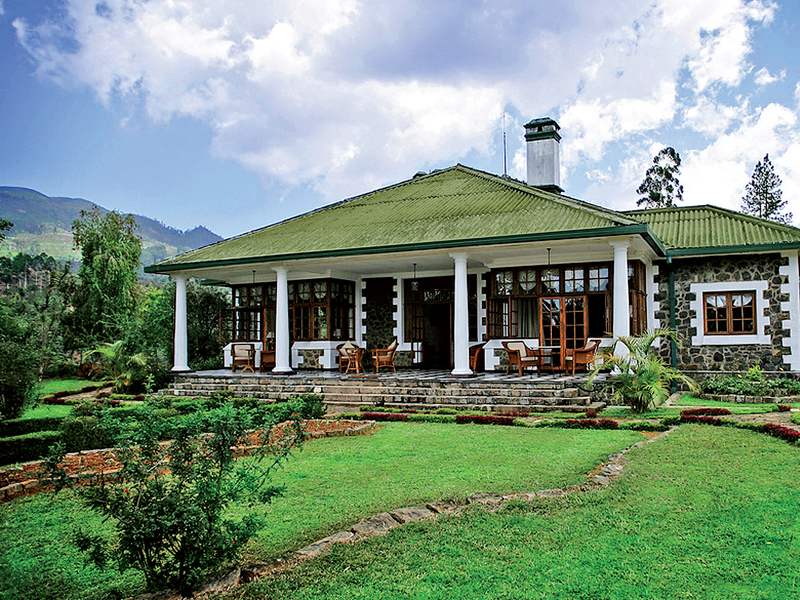
Colonial accommodation in tea planters’ bunglows at Ceylon Tea Trails.
COURTESY OF CEYLON TEA TRAILS ©
■ Detour
Sri Lanka’s cultural heartland, Kandy, is located in the northern Hill Country. Kandy’s most revered site is the gilded Temple of the Tooth Relic, said to house one of Buddha’s teeth. Pay your respects here at the morning service, a high-energy event with singing, dancing and drumming, before strolling around the lake. After soaking up the heritage sights of the old capital, spend the night at the Kandy House, a boutique hotel set in an ancestral manor on the outskirts of town, where arrack sours are poured as evening falls.
DECKCHAIR
* Cinnamon Gardens (Shyam Selvadurai) Delve into the hedonistic world of 1920s Ceylon in this Sri Lankan–Canadian novel.
* A Year in Green Tea and Tuk-Tuks (Rory Spowers) Follow journalist Spowers as he relocates with his family from London to an abandoned Sri Lankan tea estate.
* Elephant Walk (1954) Starring Elizabeth Taylor, this film explores the opulent lifestyle of British planters in Ceylon.
* Woolf in Ceylon (Christopher Ondaatje) Learn about Leonard Woolf’s years in Ceylon, before he met Virginia.
* Running in the Family (Michael Ondaatje) A vivid account of Ondaatje’s family life in Colombo and the Hill Country.
* The Fountains of Paradise (Sir Arthur C Clark) This sci-fi story features a futuristic elevator that climbs to the top of Adam’s Peak.
CHASING CHEESE AND CIDER IN ASTURIAS
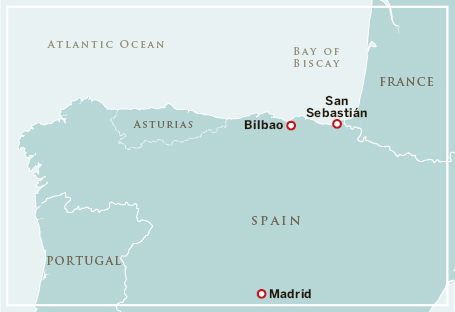
Done the tapas thing? Drunk the cerveza? How about a piece of Spain with unique flavours and intimate gastronomic experiences, right beside some of the country’s most spectacular mountain scenery? Welcome to the Cabrales region of Asturias.
ESSENTIAL EXPERIENCES
* Being assaulted by the scent of maturing cheese as you step down into one of the Picos de Europa’s cheese caves.
* Saluting the good life as you enter into the culin spirit in one of Asturias’ many bars or sidrerias.
* Mingling with the cheese’s source as you wander through the cows around the grassy Col Pandebano in the Picos de Europa.
* Paying homage at the Museo de la Sidra (Cider Museum) in Nava, Asturias’ biggest cider production centre; come in July for the Festival de la Sidra Natural.
* Finding the perfect blend of cheese and cider on the Ruta’l Quesu y la Sidra.
The cider pours like a waterfall from the waiter’s hand, tipped from on high, in the Asturian custom, to generate the required fizz. As the cider hits the glass it foams and bubbles like a sorcerer’s potion, though the sound can only just be heard over the hubbub of a weekend evening on the cobblestones of Arenas de Cabrales’ main square.
All around the square, similar apple waterfalls pour into glasses as culin – the ritual of cider tasting – continues. It’s a time-honoured tradition in this region that produces around 80% of Spanish cider – anything up to 30 million litres a year, depending on the apple harvest.
Toasts – salud! – are cried, and then the cider is quickly poured long and strong down thirsty throats. A few drinkers slug it back in a single shot, for everyone here knows that to leave the cider for more than few seconds is to lose its fizz. On each table around the square, plates are arrayed in a sea of tapas. There are black puddings, brochettes and, naturally, Cabrales’ other star culinary attraction: its wonderful cheese, veined with natural blue-green moulds (similar in style to the famed Roquefort cheeses of France) from the caves that puncture the limestone Picos de Europa, the lumpy mountain range that’s now falling into shadow behind the town.
Looking about at this scene, it’s clear that time has moved on in Asturias and Cabrales. Once considered an epicurean black hole between the famed pintxos (tapas) of San Sebastian and the pulperias (octopus restaurants) of Galicia, it was a place of peasantry, where the food – fabada (bean stew), sausage, chorizo – was typically as solid and unadulterated as its mountains. In this square tonight, however, you can see that this land of cheese and cider is now as enticing as the metaphoric land of milk and honey. It’s an experience to drink to. Salud!
LOCATION ASTURIAS, SPAIN | BEST TIME OF YEAR SPRING AND AUTUMN | IDEAL TIME COMMITMENT THREE TO FIVE DAYS | ESSENTIAL TIP IF VISITING THE REGION IN SUMMER, BOOK AHEAD – IT’S A POPULAR DOMESTIC HOLIDAY DESTINATION | BUDGET $ | PACK A HEAD TORCH – FOR VISITING THE CHEESE CAVES
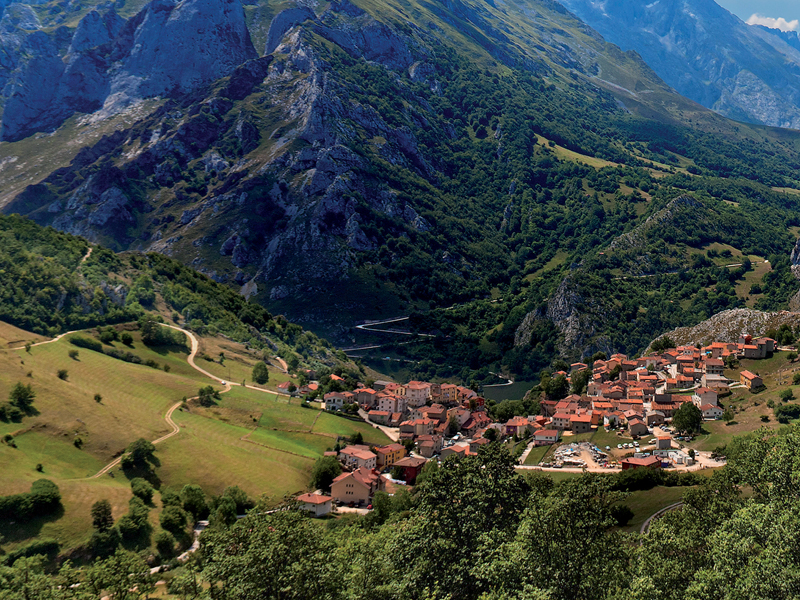
Sotres is the highest town in the Picos de Europa National Park; queso de Cabrales is ripened in its cool, limestone caves. The town is a good base for exploring local walking trails.
PILAR AZAÑA TALÁN | GETTY IMAGES ©
GARGANTA DEL CARES
If you want to walk off all that cheese and cider, you’ve come to the right mountains. The rugged Picos de Europa is laced with trails, including the spectacular Ruta del Cares, one of the most popular walking trails in Spain. This 11km path cuts through the Garganta del Cares, a limestone gorge almost as deep as the Grand Canyon. Splitting the Picos like a fracture, the gorge and trail begin in the village of Poncebos, near Arenas de Cabrales, following a path blasted through the high cliffs to the town of Cain, at the gorge’s head.
■ The Perfect Getaway
In Cabrales it’s said that the higher the village, the better the cheese. And there’s no higher village than Sotres. At the edge of the village, with its steep, winding lanes and stone houses, you’ll find Quesería Maín, where computer-programmer-turned-cheesemaker Jessica López Fernandez produces some of the finest cheese around – in 2011 her cheese won the top prize at the Certamen del Queso contest.
The operation is low-key and simple, but welcoming of visitors – in 2012, Quesería Maín began construction of visitor facilities that will include cheese-making courses. Until then, drop-in visitors are welcome; ask at the Hotel Sotres.
Inside the quesería, Jessica prepares the curds, drying them for two to three weeks in a refrigerated room before moving them into the Picos de Europa’s caves – natural caves that are still used for cheese making. The highest cave is at 1600m – requiring a two-hour walk – where the temperature lingers at around 6°C, and the air is thick with humidity and the pungency of cheese.
Across the valley, in hilltop Asiego, you’ll find an equally personal gastronomic experience on the Ruta’l Quesu y la Sidra (Cheese and Cider Route). Cider maker Javier Niembro leads guests on a two-hour walk into a cheese cave and through his 20 hectares of apple orchards, from where 10 varieties of apple are blended to create ciders at the small Sidreria Niembro. It’s at the sidreria, among the narrow squeeze of Asiego’s medieval streets, that you’ll finish your stroll. Depending on the season, there may be apples being pressed or bottled around you (the fruit is collected in October and November), while at any time of year there’ll be a mouthwatering tapas meal over which to linger.

DAVID R. FRAZIER PHOTOLIBRARY, INC. | ALAMY ©
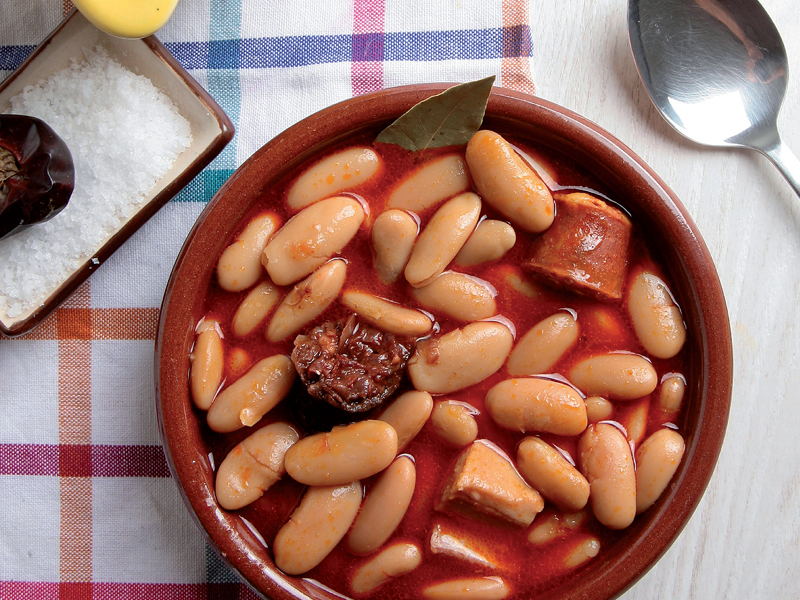
You can buy sausage in the markets of Asturias with which to make the regional speciality fabada.
JUAN CARLOS DE LA CALLE VELEZ | ISTOCKPHOTO ©
■ Plan It
Asturias Airport at Santiago del Monte is the most convenient airport for Cabrales. It’s about 150km away by road, so consider hiring a car, which also makes it easier to reach places such as Sotres and Asiego. Otherwise, Alsa buses connect via Oviedo (50km from the airport) to Arenas de Cabrales. In summer the Picos de Europa crawls with visitors, so come on the cusp of the season or book ahead. Arenas de Cabrales is the most convenient base.
■ Detour
Deviate east to San Sebastian, the Basque city with a reputation as one of the planet’s premier dining tables. Said to have more Michelin stars per capita than anywhere else on earth, it’s a destination that chef Ferran Adriá (of elBulli fame) has described as the finest place to eat in the world. Pintxo – the Basque version of tapa – is San Sebastian’s star. It’s a bite-sized culinary art form, with some of the finest found in pintxo bars such as La Cuchara de San Telmo and Astelena. Wash ’em down with a glass of txakoli, the young Basque white wine.
DECKCHAIR
* A Food Lover’s Pilgrimage to the Camino de Santiago (Dee Nolan) A personal account of the famed walk across northern Spain incorporating local food traditions.
* La Regenta (Leopoldo Alas y Ureña) A 19th-century tangled love circle in fictional Vetusta, a thinly veiled version of the Asturian city Oviedo.
* The Cuisines of Spain: Exploring Regional Home Cooking (Teresa Barrenechea) An appetising book on Spanish food.
* Walks and Climbs in the Picos de Europa (Robin Walker) An après-cheese guide to the mountains that dominate the view wherever you are in Cabrales.
* Vicki Cristina Barcelona (2008) Asturias takes centre stage in this Woody Allen movie, much of it set in Oviedo; the locals loved it so much that they’ve erected a statue of Allen.